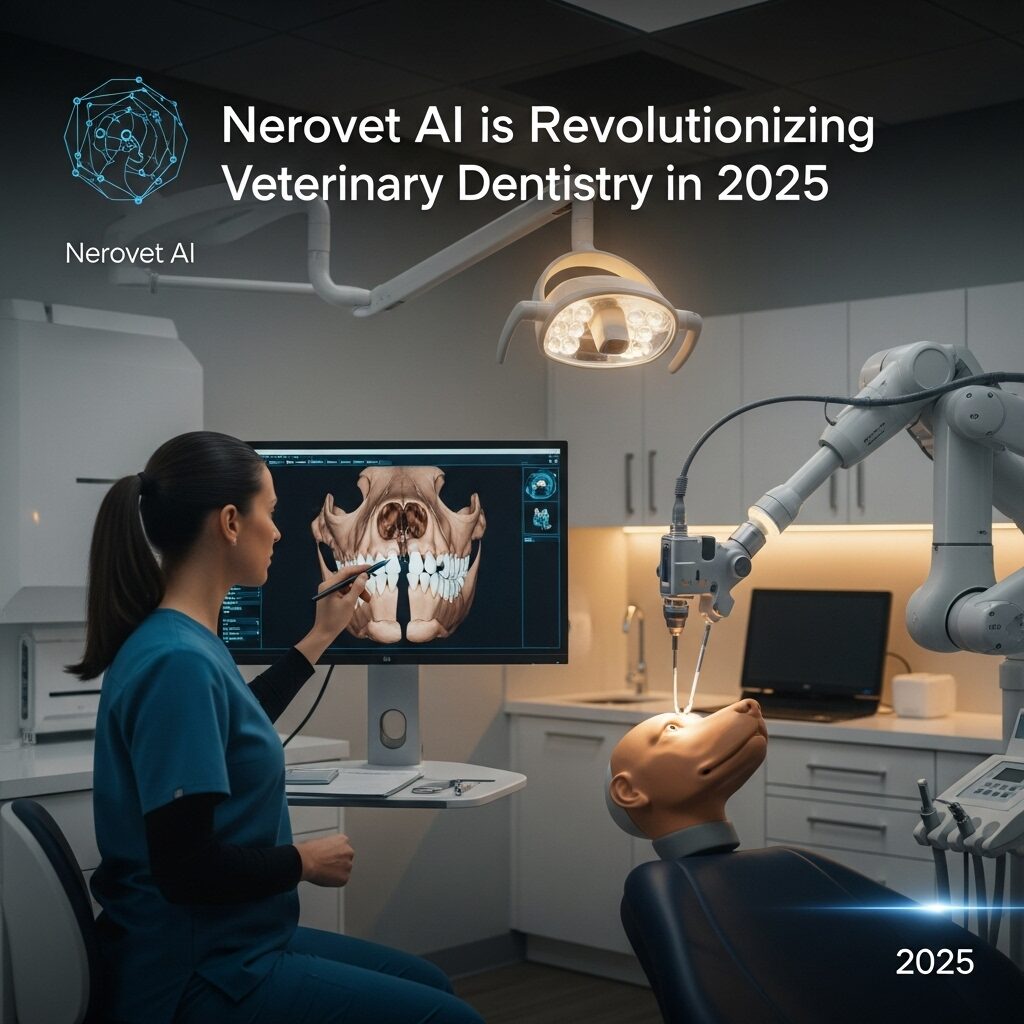Nerovet AI is at the center of the quick changes happening in veterinary dentistry. It helps vets give animals safer, faster, and better dental care by employing artificial intelligence to make sure that diagnoses and treatment plans are correct. This technology is setting new norms for pet health in 2025, making veterinary dentistry smarter and more trustworthy.
Artificial intelligence is revolutionizing the way vets clean and care for animals’ teeth. AI dentistry technology is not only making diagnosis more accurate, but it is also revolutionizing how veterinary dental clinics work in general. Veterinarians all across the world are starting to use AI more and more. It can help them spot early indicators of mild periodontal disease and plan difficult dental operations.
Nerovet AI dentistry is one of the first organizations to offer a full range of services for veterinarians in this field. This method fixes the exact problems that vets have when they clean the teeth of animals of all sizes and kinds. It’s clear that pet dental care is changing a lot as we look at how AI is being used in veterinary dentistry now and what it could accomplish in the future.
What is Nerovet AI?
Nerovet AI represents a cutting-edge approach to veterinary dental diagnostics and treatment planning. This sophisticated platform combines machine learning algorithms with veterinary-specific dental imaging to provide practitioners with unprecedented insight into their patients’ oral health.
How Nerovet AI Works
The technology looks at digital radiographs, intraoral photos, and other diagnostic pictures to find patterns that the human eye might not be able to see. Nerovet AI may find small changes in bone density, dental structure, and soft tissue that often happen before obvious symptoms. This is different from standard diagnostic procedures that only use the knowledge and experience of veterinarians.
Specialization in Animal Anatomy
What sets Nerovet AI unique from standard AI dental software is its specialism in animal anatomy. The platform has learned from thousands of veterinary dentistry cases involving a wide range of animals, from small pets to large herds. This type of training for each species lets the AI take into consideration the peculiarities in the bodies of dogs, cats, horses, and other animals.
The platform works well with practice management software and digital imaging technologies that are already in use. This makes it easier for vets to improve their productivity. You can submit images straight from dental radiography equipment, and the system will make complete analysis reports in just a few minutes. These reports point out problems, offer treatment plans, and advise times for follow-up appointments to ensure that the patient gets the best care possible.
Nerovet AI also has strong predictive modeling skills that let vets see how dental problems will get worse over time. This powerful tool is very useful for making long-term treatment plans and teaching pet owners how important it is to take care of their pets’ teeth to keep them healthy.
Benefits of Nerovet AI for Vets
The implementation of AI dental care technology in veterinary practices brings significant advantages, including:
- Improved Clinical Outcomes: Enhances accuracy in diagnosing and treating dental conditions.
- Increased Practice Efficiency: Streamlines workflows, saving time for both veterinarians and staff.
- Beyond Diagnostics: Transforms the overall approach to veterinary dental medicine, offering innovative tools for comprehensive care.
Enhanced Diagnostic Accuracy
One of the most significant benefits of AI dental diagnostics is the dramatic improvement in diagnostic precision. Traditional veterinary dental examinations rely heavily on visual inspection and tactile examination, which can miss early-stage periodontal disease or subtle radiographic changes. Nerovet AI can detect variations in bone density as small as 2-3%, identifying conditions weeks or even months before they become clinically apparent.
This early detection capability is particularly crucial in veterinary medicine because animals often hide pain and discomfort. By the time dental problems become visible through conventional examination methods, the condition may have progressed to a stage requiring more invasive and expensive treatment.
Improved Treatment Planning
AI dental technology excels at creating comprehensive treatment plans based on objective data analysis. The system can evaluate multiple factors simultaneously—including the patient’s age, breed, medical history, and current dental condition—to recommend the most appropriate treatment approach.
For complex cases involving multiple dental issues, Nerovet AI can prioritize treatments based on urgency and expected outcomes. This systematic approach helps veterinarians make more informed decisions about which procedures to perform immediately and which can be scheduled for future appointments.
Consistent Quality Standards
Human diagnostic capabilities can vary based on fatigue, experience level, and other subjective factors. AI dental software provides consistent analysis regardless of external circumstances, ensuring that every patient receives the same high standard of diagnostic evaluation.
This consistency is particularly valuable in multi-veterinarian practices where different doctors might interpret the same radiographs differently. Nerovet AI serves as an objective second opinion, helping to standardize diagnostic criteria across the entire practice.
Client Communication Enhancement
Nerovet AI’s visual reports are great tools for teaching clients. Veterinarians can display pet owners clear, labeled pictures that illustrate problem regions and show why treatment is necessary instead of trying to explain complicated dental problems using technical terms.
These graphic aids make it much easier for clients to understand and follow therapy recommendations. Pet owners are more likely to agree to necessary surgeries and follow through with preventive care advice when they can see exactly what’s wrong with their pet’s teeth.
How Nerovet AI Improves Accuracy and Efficiency
When AI is used in veterinary settings, it works well with the expertise of veterinarians. This partnership doesn’t take the place of the veterinarian’s clinical judgment; instead, it adds to it with data-driven insights that couldn’t be gotten by traditional means alone.
Real-Time Analysis Capabilities
Nerovet AI processes dental images in real-time, providing immediate feedback during the examination process. This instant analysis allows veterinarians to make on-the-spot decisions about additional imaging needs, anesthesia duration, and treatment modifications.
The real-time capability is particularly beneficial during dental procedures performed under anesthesia.Veterinarians can get instant feedback on how well their procedures worked instead of having to wait for post-procedure analysis. They can then make changes as needed within the same anesthesia episode.
Pattern Recognition and Learning
The AI dental diagnostics system becomes better at its job as it learns from new cases all the time. Every case that is looked at adds to the platform’s knowledge base, which makes it better at finding rare conditions and strange presentations.
Because Nerovet AI can learn, practices that use it can gain from both their own cases and the experiences of all the other users. The AI can find comparable situations in other places by looking for rare diseases that have been found in one practice.
Workflow Integration
Modern veterinary practices operate on tight schedules, and any new technology must integrate seamlessly into existing workflows. Nerovet AI has been designed with this requirement in mind, fitting naturally into the standard dental examination and treatment process.
The platform can automatically populate treatment estimates, generate client education materials, and create follow-up reminders based on its diagnostic findings. This automation reduces administrative burden while ensuring that important follow-up care isn’t overlooked.
Quality Assurance and Documentation
AI dental technology provides comprehensive documentation of diagnostic findings and treatment decisions. This detailed record-keeping is invaluable for practice quality assurance, continuing education, and potential legal protection.
The system can also identify cases where its diagnostic confidence is lower, flagging these for additional veterinary review. This self-awareness helps maintain high standards while preventing over-reliance on automated analysis.
Real-World Applications of Nerovet AI in Dental Practices
The practical applications of Nerovet AI dentistry extend across all aspects of veterinary dental care, from routine prophylaxis to complex oral surgery. Understanding these applications helps illustrate the transformative potential of this technology.
Periodontal Disease Detection
One of the most prevalent problems that veterinarians see is periodontal disease, which affects more than 80% of dogs and 70% of cats by the time they are three years old. Traditional diagnosis depends on looking at and probing, which can overlook disease in its early stages.
Nerovet AI can look at X-rays to find little patterns of bone loss that are common in early periodontal disease. The technology finds changes in bone density and trabecular patterns that happen before evident clinical indications. This lets doctors act sooner and leads to better long-term results.
Endodontic Evaluation
Root canal therapy and other endodontic procedures require precise assessment of tooth vitality and internal anatomy.AI dental diagnostics can look at X-ray images to figure out the size of the pulp chamber, the shape of the root canal, and any evidence of pulp necrosis or infection.
This detailed analysis helps veterinarians determine whether endodontic treatment is viable or if extraction is the better option. The AI can also predict the complexity of potential endodontic procedures, helping with treatment planning and client communication.
Orthodontic Assessment
Veterinary orthodontics is a growing specialty area, particularly for show animals and working dogs. Nerovet AI can analyze jaw alignment, tooth positioning, and growth patterns to identify orthodontic problems and predict treatment outcomes.
The technology can also keep track of how well orthodontic treatment is going by comparing follow-up photos to baseline measures to make sure that everything is going according to plan.
Oral Pathology Detection
Early detection of oral tumors and other pathological conditions is crucial for successful treatment outcomes. AI dental technology can identify subtle tissue changes and unusual growth patterns that might be missed during routine examination.
Implant Planning
AI implants planning is an emerging application that shows tremendous promise for veterinary dentistry. The technology can analyze bone quality and quantity to determine optimal implant placement sites and predict integration success.
While veterinary dental implants are still relatively uncommon, advances in AI dental technology are making these procedures more predictable and accessible to general practitioners.
Future Trends in Veterinary Dentistry with AI
The future of AI dentistry in veterinary medicine holds exciting possibilities that extend far beyond current diagnostic and treatment capabilities. AI is expected to facilitate the development of advanced diagnostic tools, enabling veterinarians to detect oral health issues at even earlier stages. Furthermore, AI-driven innovations such as robotic-assisted surgeries and personalized treatment plans tailored to each animal’s specific needs could revolutionize veterinary dental care. Ultimately, these emerging trends promise to improve treatment outcomes and elevate the standard of care in veterinary dentistry worldwide.
Frequently Asked Questions (FAQs)
1. What is veterinary dentistry?
Veterinary dentistry involves the diagnosis, prevention, and treatment of oral health issues in animals. It includes procedures such as dental cleanings, tooth extractions, and the treatment of oral diseases to ensure animals maintain healthy teeth and gums.
2. How can AI support veterinary dentistry?
AI can enhance veterinary dentistry by improving diagnostic accuracy, enabling early detection of oral issues, and assisting in the development of customized treatment plans. Additionally, AI-driven tools can aid in robotic-assisted surgeries for more precise procedures.
3. Why is dental care important for animals?
Just like humans, animals can suffer from oral health problems that may lead to pain, difficulty eating, or even systemic health issues. Regular dental care can help prevent these problems and improve their overall well-being.
4. Are there specific advancements on the horizon for veterinary dentistry?
Yes, emerging technologies such as AI-powered diagnostic tools and personalized treatment solutions are set to revolutionize veterinary dentistry, making it more effective and efficient. These advancements aim to elevate the standard of care for animals globally.




